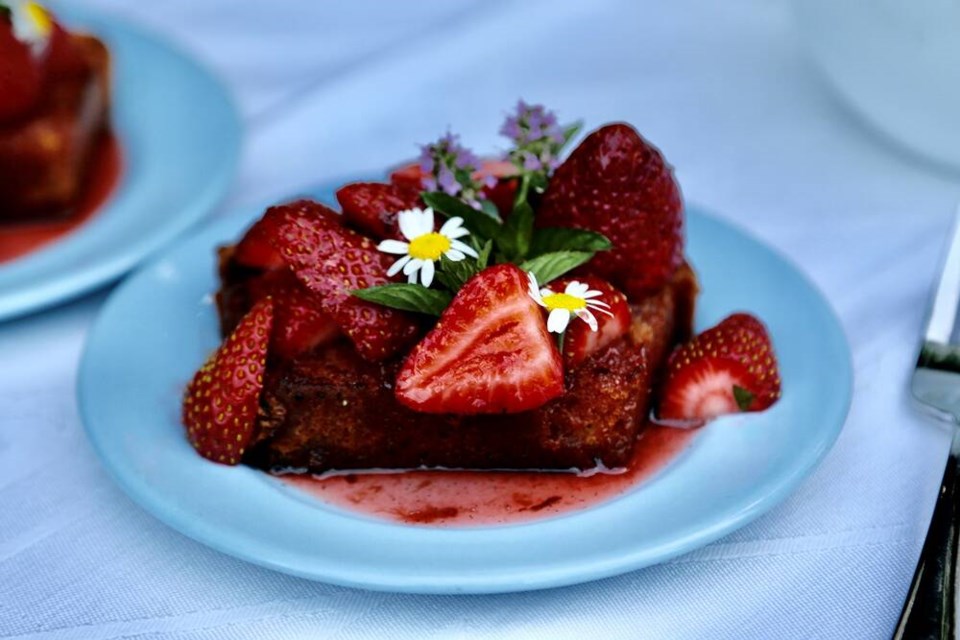John Lennon may have been onto something bigger than psychedelics when he wrote the iconic single Strawberry Fields Forever in 1966.
Strawberries, as it turns out, are a “super-duper food.” Not all strawberries, rather organic and wild ones, especially the sort that ramble across fields and sprawl across sidewalks to trip up unsuspecting runners.
I first encountered the extraordinarily resilient wild berry in the Clayoquot Sound Biosphere Reserve in 1997. Coastal, or beach strawberries, Fragaria chiloensis (Salish st’i’luqw) grow low near the sea on rocks and sandy dunes.
Tiny, dark-red beach strawberries are dense with flavour and complex nutrition, and their fragrance is palpable – an olfactory call to the wild. Salish elders speak of hunting during strawberry season, when animals emerged from the forest to feast near the sea.
In our garden, veggie dog Dave roots through living-mulch hedges of alpine strawberry plants, alternating yellow and red, searching for pudding-soft berries the size of baby peas. He chooses the red berries first, mining his way across the rows until all that is left are the yellow. To me, yellow and red berries are equally sweet, but canine instincts discriminate.
Perhaps it is the bioactives – those good-for-you phytochemicals found in organic and wild strawberry flesh and seeds – that speak silently to Dave, and to the birds that dart in and out of the low canopy of leathery dark-green leaves.
Thanks to peer-reviewed and published research and studies done by universities like Tufts, Harvard and Texas A&M, and by physician authors like Dr. William Li, we are learning the science behind the intuition. We know that bioactive elements found in wild and organic strawberries benefit all of our body’s primary operating, defense and regenerative systems – contributing to a healthy immune system, DNA protection, gut biome balance, cardiovascular health and so much more.
It is worth noting that on average, non-organic strawberries imported from the U.S. are considered among the most heavily sprayed crops in North America. According to the EWG’s 2023 Shopper’s Guide to Pesticides in Produce, strawberries topped the Dirty Dozen list of 46 items included in their analysis. More than 90 per cent of strawberries sampled tested positive for two or more pesticides.
The good news is that strawberries are easy to grow at home in our gardens, patio containers, and window boxes. Wild strawberries love to struggle in sunny residence among rocky piles, cracked driveway pavers, and in almost any depression that will hold rich, organic soil. Over time, if left more-or-less to their own, strawberry plants create more soil, as old leaves, dead bugs, bird poop and other organics break down naturally.
Over time we have amassed a collection of wild, native and alpine strawberry varieties at various elevations in our gardens. We use them as a living mulch to provide shade and habitat while cooling the soil and reducing evaporation, and also to eliminate weed pressure beneath hedges and fruit trees. A galvanized metal dust bin parked outside the kitchen door houses generations of strawberry plants that require little more of me than a regular supply of spent vegetable-washing water, super-charged with living soil biology.
From late spring straight through to December, I rely on our strawberries as garnishes or main attractions in salads, desserts, stews, smoothies, juices and preserves. We graze them daily, without restrictions as we come and go, entertain family and friends, and tend to the gardens.
We know intuitively, and now empirically, that our wild and alpine strawberries grown in organic living soil are super-duper good for us. Garden centres are bursting with strawberry plants. Time to get growing.
Laura Marie Neubert is a West Vancouver-based urban permaculture designer. Follow her on Instagram @upfrontandbeautiful, learn more about permaculture by visiting her Upfront & Beautiful website or email your questions to her here.
For a taste of permaculture, click on the YouTube link below:




